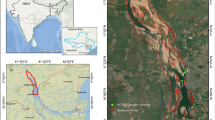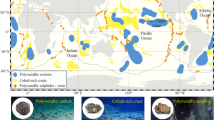Abstract
A newly developed Deep Ocean Compact Autonomous Raman Spectrometer (DOCARS) system is introduced and used for in-situ detection of acid radical ions in this paper. To evaluate the feasibility and capability of DOCARS for quantitative analysis of the acid radical ions in the deep ocean, extensive investigations have been carried out both in laboratory and sea trials during the development phase. In the laboratory investigations, Raman spectra of the prepared samples (acid radical ions solutions) were obtained, and analyzed using the method of internal standard normalization in data processing. The Raman signal of acid radical ions was normalized by that of water molecules. The calibration curve showed that the normalized Raman signal intensity of SO 2−4 , NO −3 , and HCO −2 increases linearly as the concentration rises with correlation coefficient R 2 of 0.99, 0.99, and 0.98 respectively. The linear function obtained from the calibration curve was then used for the analysis of the spectra data acquired in the sea trial under a simulating chemical field in the deep-sea environment. It was found that the detected concentration of NO −3 according to the linear function can reflect the concentration changes of NO −3 after the sample was released, and the detection accuracy of the DOCARS system for SO 2−4 is 8%. All the results showed that the DOCARS system has great potential in quantitative detection of acid radical ions under the deep-sea environment, while the sensitivity of the DOCARS system is expected to be improved.
Similar content being viewed by others
References
Battaglia T M, Dunn E E, Lilley M D, Holloway J, Dable B K, Marquardt B J, Booksh K S. 2004. Development of an in situ fiber optic Raman system to monitor hydrothermal vents. Analyst, 129(7): 602–606.
Breier J A, German C R, White S N. 2009. Mineral phase analysis of deep-sea hydrothermal particulates by a Raman spectroscopy expert algorithm: toward autonomous in situ experimentation and exploration. Geochemistry Geophysics Geosystems, 10(5), http://dx.doi.org/10.1029/2008GC002314.
Brewer P G, Malby G, Pasteris J D, White S N, Peltzer E T, Wopenka B, Freeman J, Brown M O. 2004. Development of a laser Raman spectrometer for deep-ocean science. Deep-Sea Research I, 51(5): 739–753.
Cheng K, Hou H M, Li D P, Guo J J, Zhao G T, Zheng R E. 2011. Design and sea trial on a sample releasing device used for deep-sea in-situ laser Raman spectroscopy system. Journal of Harbin Engineering University, 32(8): 1 058–1 062. (in Chinese with English abstract)
Guo J J, Zheng R E, Cheng K, Qi F J, Li Y. 2009. Shiyong Xinxing Zhuanli Shuomingshu. CN 201302547Y. (in Chinese)
Hester K C, White S N, Peltzer E T, Brewer P G, Sloan E D. 2006. Raman spectroscopic measurements of synthetic gas hydrates in the ocean. Marine Chemistry, 98(2): 304–314.
Jorgensen B B, Kasten S. 2006. Sulfur cycling and methane oxidation. In: Schulz H D eds. Marine Geochemistry. 2 nd edn. Springer-Verlag Berlin Heidelberg, Berlin, Germany. p.271–302.
Liu G Q, Ma L X, Liu J. 2002. Handbook of Chemistry and Chemical Properties-Inorganic Volume. Chemical Industry Press, Beijing, China, p.329, 363, 423.
McCreery R L. 2000. Raman Spectroscopy for chemical analysis. John Wiley & Sons, New York, USA. p.28.
Pasteris J D, Wopenka B, Freeman J J, Brewer P G, White S N, Peltzer E T, Malby G E. 2004. Raman spectroscopy in the deep ocean: successes and challenges. Applied Spectroscopy, 58(7): 195A–208A.
Pelletier M J. 1999. Analytical Applications of Raman Spectroscopy. Blackwell Science Ltd., Oxford. p.478.
Reeburgh W S. 2007. Oceanic Methane Biogeochemistry. Chem. Rev., 107(2): 486–513.
Sherman A D, Walz P M, Brewer P G. 2007. Two generations of deep-ocean Raman in situ spectrometers-Lessons Learned While Optimizing Instrument Robustness and Sensitivity. Sea Technology, 48(2): 10–13.
White S N. 2009. Laser Raman spectroscopy as a technique for identification of seafloor hydrothermal and cold seep minerals. Chemical Geology, 259(3): 240–252.
Zhang X, Walz P M, Kirkwood W J, Hester K C, Ussler W, Peltzer E T, Brewer P G. 2010. Development and deployment of a deep-sea Raman probe for measurement of pore water geochemistry. Deep-Sea Research I, 57(2): 297–306.
Author information
Authors and Affiliations
Corresponding author
Additional information
Supported by the National High Technology Research and Development Program of China (863 Program) (Nos. 2006AA09Z243, 2012AA09A405)
Rights and permissions
About this article
Cite this article
Du, Z., Li, Y., Chen, J. et al. Feasibility investigation on deep ocean compact autonomous Raman spectrometer developed for in-situ detection of acid radical ions. Chin. J. Ocean. Limnol. 33, 545–550 (2015). https://doi.org/10.1007/s00343-015-4096-8
Received:
Accepted:
Published:
Issue Date:
DOI: https://doi.org/10.1007/s00343-015-4096-8




